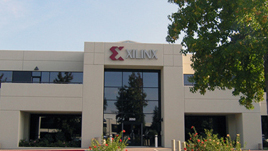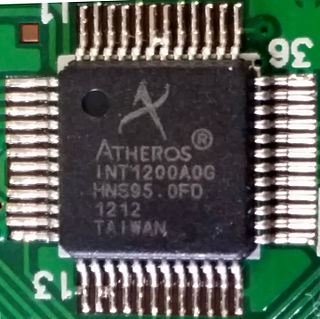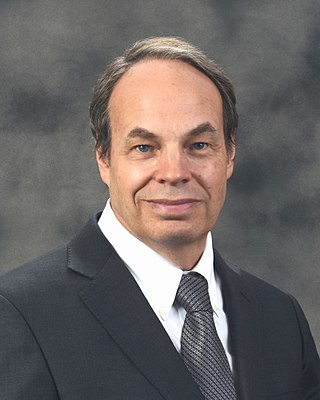
Electronics is a scientific and engineering discipline that studies and applies the principles of physics to design, create, and operate devices that manipulate electrons and other electrically charged particles. Electronics is a subfield of electrical engineering which uses active devices such as transistors, diodes, and integrated circuits to control and amplify the flow of electric current and to convert it from one form to another, such as from alternating current (AC) to direct current (DC) or from analog signals to digital signals.

A field-programmable gate array (FPGA) is a type of configurable integrated circuit that can be programmed or reprogrammed after manufacturing. FPGAs are part of a broader set of logic devices referred to as programmable logic devices (PLDs). They consist of an array of programmable logic blocks and interconnects that can be configured to perform various digital functions. FPGAs are commonly used in applications where flexibility, speed, and parallel processing capabilities are required, such as in telecommunications, automotive, aerospace, and industrial sectors.

Software-defined radio (SDR) is a radio communication system where components that conventionally have been implemented in analog hardware are instead implemented by means of software on a computer or embedded system. While the concept of SDR is not new, the rapidly evolving capabilities of digital electronics render practical many processes which were once only theoretically possible.

Xilinx, Inc. was an American technology and semiconductor company that primarily supplied programmable logic devices. The company is known for inventing the first commercially viable field-programmable gate array (FPGA). It also created the first fabless manufacturing model.

A tuner is a subsystem that receives radio frequency (RF) transmissions, such as FM broadcasting, and converts the selected carrier frequency and its associated bandwidth into a fixed frequency that is suitable for further processing, usually because a lower frequency is used on the output. Broadcast FM/AM transmissions usually feed this intermediate frequency (IF) directly into a demodulator that converts the radio signal into audio-frequency signals that can be fed into an amplifier to drive a loudspeaker.

A mixed-signal integrated circuit is any integrated circuit that has both analog circuits and digital circuits on a single semiconductor die. Their usage has grown dramatically with the increased use of cell phones, telecommunications, portable electronics, and automobiles with electronics and digital sensors.
Conexant Systems, Inc. was an American-based software developer and fabless semiconductor company that developed technology for voice and audio processing, imaging and modems. The company began as a division of Rockwell International, before being spun off as a public company. Conexant itself then spun off several business units, creating independent public companies which included Skyworks Solutions and Mindspeed Technologies.

A class-D amplifier or switching amplifier is an electronic amplifier in which the amplifying devices operate as electronic switches, and not as linear gain devices as in other amplifiers. They operate by rapidly switching back and forth between the supply rails, using pulse-width modulation, pulse-density modulation, or related techniques to produce a pulse train output. A simple low-pass filter may be used to attenuate their high-frequency content to provide analog output current and voltage. Little energy is dissipated in the amplifying transistors because they are always either fully on or fully off, so efficiency can exceed 90%.
In a radio receiver circuit, the RF front end, short for radio frequency front end, is a generic term for all the circuitry between a receiver's antenna input up to and including the mixer stage. It consists of all the components in the receiver that process the signal at the original incoming radio frequency (RF), before it is converted to a lower intermediate frequency (IF). In microwave and satellite receivers it is often called the low-noise block downconverter (LNB) and is often located at the antenna, so that the signal from the antenna can be transferred to the rest of the receiver at the more easily handled intermediate frequency.
Linear Technology Corporation was an American semiconductor company that designed, manufactured and marketed high performance analog integrated circuits. Applications for the company's products included telecommunications, cellular telephones, networking products, notebook and desktop computers, video/multimedia, industrial instrumentation, automotive electronics, factory automation, process control, military and space systems. The company was founded in 1981 by Robert H. Swanson, Jr. and Robert C. Dobkin.
Maxim Integrated, a subsidiary of Analog Devices, designs, manufactures, and sells analog and mixed-signal integrated circuits for the automotive, industrial, communications, consumer, and computing markets. Maxim's product portfolio includes power and battery management ICs, sensors, analog ICs, interface ICs, communications solutions, digital ICs, embedded security, and microcontrollers. The company is headquartered in San Jose, California, and has design centers, manufacturing facilities, and sales offices worldwide.
Precision Monolithics, Inc. also known as PMI, was an American company based in Santa Clara, California, that developed and produced mixed signal and linear integrated circuits (ICs). It was a pioneer in the fields of digital-to-analog converters and operational amplifiers.

Cadence Design Systems, Inc., is an American multinational technology and computational software company. Headquartered in San Jose, California, Cadence was formed in 1988 through the merger of SDA Systems and ECAD. Initially specialized in electronic design automation (EDA) software for the semiconductor industry, currently the company makes software and hardware for designing products such as integrated circuits, systems on chips (SoCs), printed circuit boards, and pharmaceutical drugs, also licensing intellectual property for the electronics, aerospace, defense and automotive industries, among others.
Mindspeed Technologies, Inc. designs, manufactures, develops, and sells fabless semiconductors for communications applications in wireless and wired networks.
Virtex is the flagship family of FPGA products currently developed by AMD, originally Xilinx before being acquired by the former. Other current product lines include Kintex (mid-range) and Artix (low-cost), each including configurations and models optimized for different applications. In addition, AMD offers the Spartan low-cost series, which continues to be updated and is nearing production utilizing the same underlying architecture and process node as the larger 7-series devices.

Integrated Device Technology, Inc. (IDT), was an American semiconductor company headquartered in San Jose, California. The company designed, manufactured, and marketed low-power, high-performance mixed-signal semiconductor products for the advanced communications, computing, and consumer industries. The company marketed its products primarily to original equipment manufacturers (OEMs). Founded in 1980, the company began as a provider of complementary metal-oxide semiconductors (CMOS) for the communications business segment and computing business segments. The company focused on three major areas: communications infrastructure, high-performance computing, and advanced power management. Between 2018 and 2019, IDT was acquired by Renesas Electronics.

An analog front-end is a set of analog signal conditioning circuitry that uses sensitive analog amplifiers, often operational amplifiers, filters, and sometimes application-specific integrated circuits for sensors, radio receivers, and other circuits to provide a configurable and flexible electronics functional block needed to interface a variety of sensors to an antenna, analog-to-digital converter or, in some cases, to a microcontroller.

Robert Whitlock Adams is a Technical Fellow at Analog Devices, Inc. (ADI) in Wilmington, Massachusetts. His focus is on signal processing and analog-to-digital conversion for professional audio. He is a leader in the development of sigma-delta converters, introducing architectural advances including mismatch shaping, multi-bit quantization, and continuous-time architectures.
RF CMOS is a metal–oxide–semiconductor (MOS) integrated circuit (IC) technology that integrates radio-frequency (RF), analog and digital electronics on a mixed-signal CMOS RF circuit chip. It is widely used in modern wireless telecommunications, such as cellular networks, Bluetooth, Wi-Fi, GPS receivers, broadcasting, vehicular communication systems, and the radio transceivers in all modern mobile phones and wireless networking devices. RF CMOS technology was pioneered by Pakistani engineer Asad Ali Abidi at UCLA during the late 1980s to early 1990s, and helped bring about the wireless revolution with the introduction of digital signal processing in wireless communications. The development and design of RF CMOS devices was enabled by van der Ziel's FET RF noise model, which was published in the early 1960s and remained largely forgotten until the 1990s.













